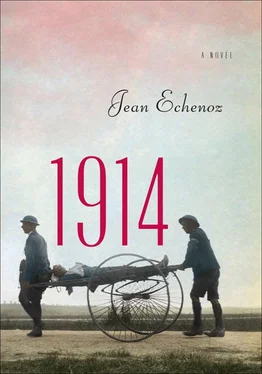shelter: In the forward trenches, officers often had better quarters than the enlisted men, but even the best dugouts were small, muddy rooms, while others were simply rectangular caves cut into the walls of the trench. Some were cubbyholes that could hold only one man, while deep dugouts might extend more than ten feet underground, but unless they were raised at least a foot above the lowest level of the trench, they could be flooded with filth and dangerous debris.
Verdun: The German hope for a swift victory when they invaded France had been stymied by Russian offensives on the east and the French victory outside Paris in “the Miracle of the Marne,” the desperate counterattack in September 1914 that broke the monthlong German offensive. After the invaders withdrew to the northeast, the Western Front solidified into a four-year war of attrition in the trenches. Hoping to end this stalemate, the Germans mounted a massive offensive at Verdun, which was now a salient on the front lines, open to attack from three sides. The Battle of Verdun (February 21–December 18, 1916) found the French initially unprepared, but German gains were slowed by French reinforcements, and both sides incurred heavy losses as the German advance bogged down. Partly to relieve German pressure on Verdun, the Allies launched their own offensive on the Somme on July 1, forcing Germany to divert men and matériel there. The Battle of Verdun dragged on until the end of the year, as the French clawed back their lost ground.
Modern estimates put the number of dead and wounded at close to a million men. After eleven months, the longest and bloodiest battle of World War I ended with no real advantage to either side.
Suippe: Le Cimetière militaire français de La Ferme de Suippe, a French National Necropolis, contains the remains of more than nine thousand combatants killed during both world wars.
At five a.m. on March 10, 1915, the French soldiers of the 21st Company of the 336th Infantry Regiment, exhausted by fighting and losses sustained during two months of fruitless combat in their sector, were ordered to launch a fresh attack on the enemy’s position north of the village of Souain. The terrain in front of them was strewn with the corpses of their comrades, cut down by withering German machine-gun fire in several recent abortive attacks or fatally enmeshed in the barbed wire both sides deployed to protect their positions. French artillery fire, intended to soften up the enemy, was instead pounding no-man’s-land and its own trenches. A witness would later claim that General Réveillac, who ordered the attack, was trying to drive his men out into the open. The French soldiers refused to budge. (During the ensuing court-martial, one of the defendants insisted that “whoever went over the top would have been literally mowed down by either our fire or the German machine-gunners.”)
Incensed, General Réveillac ordered the company commander to submit the names of eighteen soldiers and his six youngest corporals, who were brought before a court-martial. Meeting on March 16 in a room of the city hall in Suippe, the court-martial acquitted the soldiers and two corporals and condemned to death corporals Louis Girard, a watchmaker; Lucien Lechat, a café waiter; Louis Lefoulon, a railroad worker; and Théophile Maupas, a teacher. On the following day, March 17, two hours before the camp was informed that their sentences had been commuted to hard labor, the condemned were shot at the Suippe Farm.
Upon receiving the news of her husband’s execution, Blanche Maupas began her long battle seeking justice for the corporals of Souain with great courage and perseverance. In 1934, the four men were at last rehabilitated by the Special Military Tribunal for the Review of Court-Martial Convictions, and their names were cleared.
In 1957 Stanley Kubrick made Paths of Glory , based on the novel of the same name by Humphrey Cobb, which told the story of the corporals of Souain. Starring Kirk Douglas, the film was released to critical acclaim but was not shown in France until 1975.
Chemin des Dames: The Chemin des Dames is nineteen miles long, running east and west along a ridge between two river valleys. “The Ladies’ Path” was the carriage road taken in the eighteenth century by the daughters of Louis XV when traveling between Paris and the Château de Boves, but in World War I it lay in a strategic sector held by the French army on the Western Front. Pushing the invaders back after the Battle of the Marne, the Allied armies were finally halted on the ridge in September 1914 in the First Battle of the Aisne River, and by the end of January 1915 the Germans controlled that plateau. The front line remained essentially static—but not without casualties—until the Second Battle of the Aisne (April 16–25, 1917), when in what had been presented as a final French offensive for victory, General Nivelle threw seven army corps against the Chemin des Dames ridge, where the Germans were well dug in and had the high-ground advantage. After twelve days of fighting, the attackers had gained little and suffered such high casualties that the French public, kept informed by the newspapers, was outraged. After the massive losses in the battles of Verdun and the Somme, the toll taken at the Chemin des Dames shattered the morale of the disillusioned French troops. By early 1917, almost a million French soldiers had been killed in the war; those still alive were sick of the suicidal attacks demanded by their high command.
The French Army Mutinies of 1917—the startling extent of which was hidden from the public at the time—began after the debacle of the Second Battle of the Aisne: French troops at the Chemin des Dames had been deserting in increasing numbers, but deserters became mutineers as soldiers refused to obey orders for further futile assaults. Revolution was in the air: Nicholas II, the last tsar of Russia, had abdicated on March 2, 1917, and a month later, units of Allied Russian soldiers among the Chemin des Dames troops were singing “The Internationale.” In the end, almost half the French infantry at the Western Front may have taken part in insubordination at some point, encouraged at times by the stunning example of the Russian Revolution, news of which was spread by socialist newspapers and the infantry rumor mills.
Mons: Mons is the capital of the Belgian province of Hainaut, where the British Expeditionary Force fought its first battle of the Great War on August 23 and 24, 1914, against the advancing German First Army. Outnumbered by three to one, and left vulnerable when the sudden retreat of the French Fifth Army exposed their right flank, the British withdrew in good order for more than 250 miles, hard-pressed by the Germans, all the way to the outskirts of Paris. There, together with six French field armies, they were at last able to reverse the Allies’ fortunes at the last-ditch Battle of the Marne and begin driving the Germans back to what would become the infamous trenches of the Western Front.
During the Hundred Days Offensive (August 8–November 11, 1918), beginning with the Battle of Amiens, a series of Allied attacks forced the Central Powers to retreat behind the “impregnable” Hindenburg Line—permanently breached in September—and ultimately to accept an armistice. As part of this offensive, the Canadian Corps of the British First Army fought a number of battles along the Western Front from Amiens to Mons, where a memorial plaque in the city hall bears the inscription: MONS WAS RECAPTURED BY THE CANADIAN CORPS ON THE 11TH NOVEMBER 1918: AFTER FIFTY MONTHS OF GERMAN OCCUPATION, FREEDOM WAS RESTORED TO THE CITY: HERE WAS FIRED THE LAST SHOT OF THE GREAT WAR.









